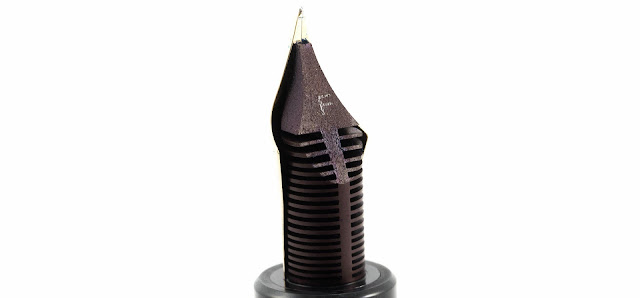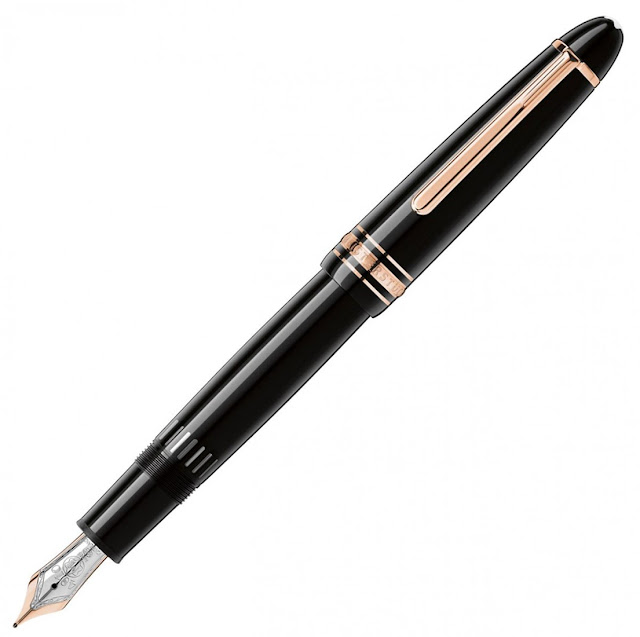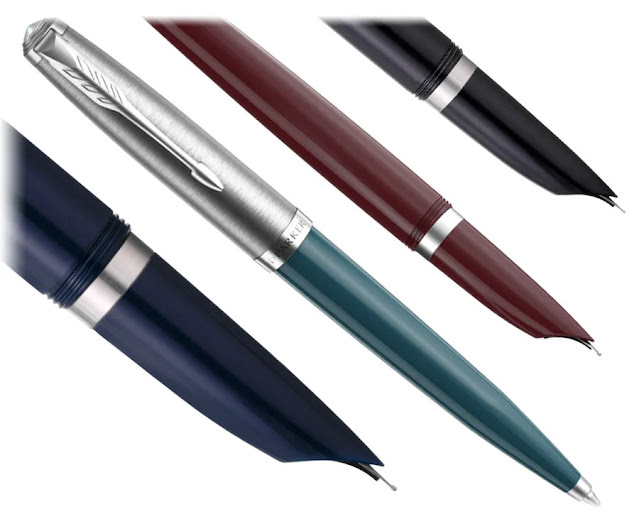A Comprehensive Guide to FP Nibs
Possibly one of the hardest decisions about writing with fountain pens is what nib to buy and what the difference is between sizes, materials and compatibility between models, hopefully by the end of this blog post you'll be ready to pick the best nib to fit your needs. We will be taking a closer look at the sizes of the tipping on the nibs, the sizes of the actual nibs, the materials that they are made of, and the compatibility of these nibs between different pen models and brands.
Nib Sizes for line width
I'm going to talk mostly about what can be purchased from brands in the retail setting mostly so I won't really touch on custom nib grinds in depth. Most brands offer a standard range of sizes but before we get to those lets talk about the general difference between Japanese and western sizes. A general rule of thumb is that Japanese nibs are one size finer than western nibs and I can say this is definitely true for Sailor and Pilot but since it is highly personal what people prefer, just take that rule with a grain of salt.
- Extra Fine- The finest nib size available from most brands is the EF and is great for fine margin note taking. I would suggest not using any shimmer or waterproof ink in an EF because the large particles in the ink are more likely to clog the small EF opening which can be frustrating to deal with. Since EF nibs also have less tipping material to make the line thinner they are more likely to have some feedback where you can feel the nib on the paper and is less likely to be glassy smooth like a Broad can be. EF nibs also tend to have very crisp lines and make the ink your using look pretty monochromatic which can improve legibility when used with some hyper-shading inks.
- Fine- The next step up is the F nib which is a little more generous and usually are a little more smooth than the EF but can still be really fine depending on the brand you buy from. This and the Medium nib are usually where I would tell people to start because they are the middle of the road and can show you what your pens can do and I see the EF and B nibs as amplifying this to an extreme level. Fine nibs are also really good for note taking because the smaller the nib the more writing and notes you can get into a smaller space so I'd suggest EF and F for note taking the most because they also preform better on cheaper paper like the ones used in schools and offices because they put down less ink.
- Medium- The true middle of the road nib is the medium and I think its also the most common nib that companies offer the most of usually because it is so popular. This is also where nibs can start to get super smooth and juicy, laying down a moderate amount of ink to get a bit more shading and character out of your inks, I would also recommend M or higher when using shimmer or permanent inks because it won't clog as easily. Medium nibs are really all around writers that are in such a size that they are pretty good for everything, some may be a little too wet to use on bad quality paper but they are great for journaling and writing on higher quality paper stock. I'd suggest Medium nibs as the best nibs for people getting their first fountain pen because you will have an idea of a starting point that you can either go down or up from.
- Broad- My personal favorite is the broad nib which put down a really fat line and provided the best character and shading from your inks, especially when paired with Tomoe River paper. These are also usually the smoothest nibs because they have the largest amount of material on the tip to provide a thicker line. A downside to B nibs is that they can take a while to dry on the page which means they aren't the best for quick notes due to the smudge factor but when doing something like journaling where there is no rush and can air dry for a little bit they perform great. When I first got into pens I started on the opposite end of the spectrum with the finer nibs but have since grown to really love the broader nibs and once you see how well the ink looks coming from a B nib I guarantee you'll add at least one to your collection.
- Stub- The last of the readily available nibs from most brands is the stub nib which is pretty much exactly what it sounds like. The nib tip is more squared off than the B nib and offers a similar thickness but with a varying line width depending on if you write straight down or if you write to the side. Stubs can be made a few different ways with some of the lower priced ones not having any tipping at all and just having the actual nib touch the paper, the other way is just like any other nib where there's a squared amount of tipping material to give it the stub shape. The varying widths make these a popular starting point for calligraphy practice or if you like your casual writing to have quite a bit of character and varying widths but are a little less common than the other sizes we've talked about so far.
Sizes of the actual nibs themselves
This may be a little confusing based on what we just talked about but the sizes in this section refer to the actual size of the whole nib and not the line width that they put out. Different brands have different sizes but for this I'll be using the Jowo and Bock nib brands because they are the most common nib makers for brands that don't choose to make their own nibs.
- #5- The smallest size nib offered from Bock and Jowo is the #5 which can be seen on smaller pens like the Kaweco sport models or new Esterbrook J and is just a smaller sized nib. This doesn't really affect the quality of writing but I do find that its less common to find a pen that has a #5 nib made of gold for some reason. Generally speaking, the #5 nib is going to be on smaller pens and is usually an option between those two pens, an example of that would be with Sailor. Although they make their own nibs, Sailor offers two sizes on both their 1911 and Proper models with the small one having a #5 size nib and a #6 on the bigger.
- #6- The most common nib size that you'll see on most modern pens is the #6 which is sort of thought of as the standard size where the #5 is small and the #8 is big. #6 nibs are kind of like the M nib where it offers a good starting point to see what you like because you can either go down or up depending on preference. This is the size that is featured on most mid to normal sized pens and even on a few oversized pens like the Leonardo MZG where you have a choice between #6 and #8. The good thing about #6 is that since it's a standard size its available in all materials including steel, gold, and titanium and is more than likely to be the size featured on your first fountain pen.
- #8- Finally we reach the biggest nib size that is pretty much exclusive to oversized pens due to how large it is and how much space is needed to store it in a cap properly. To my knowledge, a #8 steel nib is pretty uncommon and they mostly are offered in either gold or titanium which makes the price of entry a little higher for the #8 size nib. These are often paired with an ebonite feed to keep sufficient ink flow to the large nib and they tend to be quite wet writers, at least all the ones in my collection are. The experience with writing with this size of nib is something that can vary because some people find them unwieldy and prefer the #6 but some people can't get enough of the larger nibs, it really comes down to personal preference.
Nib Material
The last really big thing to consider when buying a pen or nib is what that nib is made out of because this can have some impact on writing and definitely an impact on price and value. Something else to keep in mind is that most nibs are tipped with some sort of material, usually Iridium, so the material really only affects the flexibility and spring of the nib. The reason for the tipping material is that gold is a little too soft to write with directly and steel is the opposite and may be too hard and scratchy to write with untapped in a size like EF or F.
- Steel- The most common material used in lower cost pens is stainless steel because it is corrosion resistant and thus will not rust or get funky with prolonged use. These nibs are usually paired with a plastic feed which provides the nib with the ink flow it needs to write a reliable line. Steel is pretty stiff and limits the amount of variance you can get out of a nib because you can push the nib to a wider length so usually is you buy a Steel M nib its just going to write a M sized line which is not always the case as you'll see when we get to gold. Steel is the most affordable choice and some steel nibs can write very well especially in wider nib sizes, more likely than not everyones first fountain pen starts with a steel nib.
- Gold- Once you start getting into the higher priced pens you will notice a change from steel to gold in the nib material, some steel nibs will have gold plating to make them look god but that's not what we are talking about here. The true gold nibs are made from solid gold in either 14, 18 or 21 karat and can be paired with a plastic, ebonite or in rare cases an aluminum feed. The draw of the gold is that it is softer than steel and will usually be a little more flexible which allows for more line variation and expression in your writing. These are usually only on more expensive pens although there are a few reasonably priced gold nib pens that start around the $160 mark.
Compatibility
Compatibility is something that can really help out if you don't want to accumulate a bunch of pens in different nibs or if you just want to have extra nibs to switch into a pen. Jowo and Bock are the most commonly used nib manufacturers outside of brands making their own nibs which is nice because any pen that uses a Jowo nib can switch nibs and its the same for Bock. You do still have to account for the size because if I have a pen with a #5 Jowo nib I will have to switch it with another #5 Jowo whether its from a different pen or a spare nib, same for #6. A #6 sized nib can't go into a pen that uses a #5. Other than that it varies from brand to brand so always be cautious when taking nibs out or swapping and make sure that everything matches up before you do it, if you ever have questions feel free to give us a call and we'd be happy to try and help.

















































